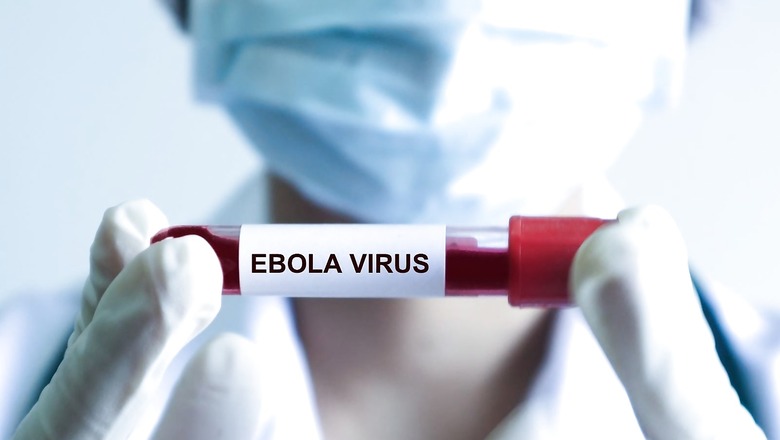
views
Move over coronavirus and monkeypox, Ebola is back to strike fear after an outbreak was declared in Uganda as health authorities confirmed a case of the relatively rare Sudan strain, the World Health Organization (WHO) said. A 24-year-old man in Uganda’s central Mubende district showed symptoms and later died. “We want to inform the country that we have an outbreak of Ebola which we confirmed yesterday,” Diana Atwine, the health ministry’s permanent secretary, told a news conference. She said the patient with the confirmed case had a high fever, diarrhoea, and abdominal pains and was vomiting blood. He had initially been treated for malaria.
There are currently eight suspected cases receiving care in a health facility, WHO’s Africa office said in a statement, adding that it was helping Uganda’s health authorities with their investigation and deploying staff to the affected area.
The WHO said there had been seven previous outbreaks of the Ebola Sudan strain, four in Uganda and three in Sudan. It said Uganda last reported an outbreak of Ebola Sudan strain in 2012 and an outbreak of the Ebola Zaire strain in 2019.
News18 brings to you a lowdown on the disease, symptoms, and treatment available:
Q.What is Ebola?
First identified in 1976 in the DRC (then Zaire), the virus, whose natural host is the bat, has since set off a series of epidemics in Africa, killing around 15,000 people. The virus causes problems with how your blood clots and is known as a haemorrhagic fever virus since the clotting problems lead to internal bleeding. The virus also causes inflammation and tissue damage.
Q.How does it spread?
Ebola is spread through direct contact with body fluids — blood, saliva, sweat, tears, mucus, vomit, feces, breast milk, urine, and semen — of people infected with it. It is also spread by touching things that have been contaminated with these fluids.
Researchers consider the fruit bat as the most likely natural reservoir of the virus.
Q.What are the symptoms?
The symptoms may appear anywhere between two and 21 days and can be sudden. Fever, fatigue, sore throat, muscle pain, and headache are the initial symptoms. Soon, more severe symptoms such as vomiting, diarrhoea, rashes, and impaired kidney or liver functions follow. In certain cases, patients may have both internal and external bleeding such as oozing from the gums, low white blood cell and platelet counts and elevated liver enzymes.
Q.Treatment available
According to WHO, two monoclonal antibodies — Inmazeb and Ebanga — were approved for the treatment of Zaire Ebolavirus infection in adults and children by the US Food and Drug Administration in late 2020. Aside from this, supportive care such as rehydration with oral or intravenous fluids and treatment of specific symptoms are used. Currently, blood products, immune therapies and drug therapies are being evaluated.
Q.Prevention
The WHO says in order to avoid catching the infection, animal products (meat) should be cooked thoroughly before consumption. Animals should be handled with gloves and other appropriate protective clothing.
While caring for an infected patient, gloves and appropriate personal protective equipment (PPE) should be worn when taking care. Direct contact with an infected person and bodily fluid must be avoided. Hand washing after caring for a patient or visiting a hospital is advised.
Monitoring health for Ebola-related symptoms should be done by a person who has had contact with an infected person for at least 21 days.
Since a risk for transmission through sex is possible, WHO recommends that male survivors of EVD practice safer sex and hygiene for 12 months from onset of symptoms or until their semen tests negative twice for the virus.
Before breastfeeding, survivors of acute Ebola virus should get their breast milk test for the virus. Pregnant women should be encouraged to attend frequent antenatal care (ANC) visits, to handle any pregnancy complications.
Q.Myths vs reality
Myth 1: I can catch Ebola by sitting next to someone who has it
According to CDC, the chances of this happening are very unlikely. The Ebola virus does not spread like the flu; it spreads through direct contact with the blood, secretions, or other body fluids of ill people. It can also be spread by “indirect contact,” such as contact with needles contaminated with these fluids.
Myth 2: Ebola is the most dangerous disease that humans have ever encountered
While the mortality rate for the current outbreak is about 55 per cent, the total number of people who have died in the outbreak is far lesser compared to earlier epidemics. In the 1300s, the plague killed between 30 to 60 per cent of Europe’s population. And according to the World Health Organization, an estimated 36 million people have died since the first cases of HIV/AIDS were reported in 1981, and 1.6 million people died of HIV/AIDS in 2012 alone.
Myth 3: Travel bans will help curb the spread of Ebola
In the past, some nations have banned flights from other countries in hopes of blocking the entry of viruses, including SARS and H1N1 (swine flu). None of the bans were effective, and the viruses spread regardless of government measures took to keep them out. Travel restrictions, in fact, may hamper the work of aid workers. Stigma makes it even harder for those who want to help.
Q.India & Ebola?
In 2014, when the virus was at its peak, there were nearly 45,000 Indian nationals living and working in Guinea, Liberia, Sierra Leone and Nigeria — where an outbreak of the disease had killed 932 people.
Faced with a possible outbreak, India responded to the Ebola threat by relying on its previous experience with epidemics like SARS and H1N1. The government designated hospitals in state capitals and major cities as Ebola management centres, asked states to form rapid response teams that were trained by World Health Organisation and US Centers for Disease Control experts, set up screening at international airports and 24-hour Ebola helplines.
Experts had then warned about the virus making its way to densely populated and poverty-stricken countries like India. In an interview with the Guardian newspaper, Peter Piot, who discovered the virus, had said, “An outbreak in Europe or North America would quickly be brought under control. I am more worried about the many people from India who work in trade or industry in West Africa.”
“It would only take one of them to become infected, travel to India to visit relatives during the virus’s incubation period, and then, once he becomes sick, go to a public hospital there. Doctors and nurses in India too often don’t wear protective gloves. They would immediately become infected and spread the virus.”
Read all the Latest Explainers News and Breaking News here
















Comments
0 comment